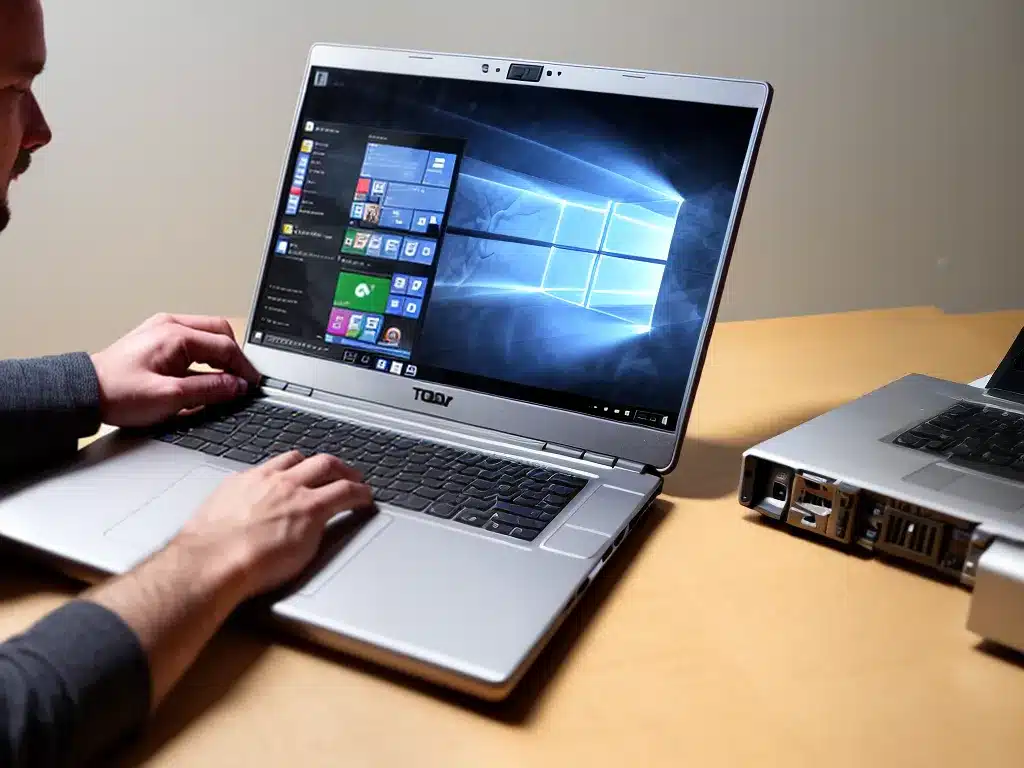
Having your laptop shut down unexpectedly can be extremely frustrating. However, there are several steps you can take to diagnose and hopefully resolve the issue. Here is a comprehensive guide on how I troubleshoot and fix a laptop that is shutting down unexpectedly:
1. Rule Out Overheating Issues
Overheating is one of the most common causes of unexpected laptop shutdowns. Here are some things I do to check for overheating problems:
-
Clean the laptop’s air vents and fans. Use a can of compressed air to blow out any dust buildup that could be blocking airflow.
-
Check the CPU and GPU temperatures. Download a system monitoring app like Speccy or HWMonitor to check if your components are overheating. They should stay below 90°C when under load.
-
Replace the thermal paste on the CPU and GPU if it’s dried out. This can reduce temperatures by 10°C or more.
-
Elevate the laptop and use a cooling pad to improve airflow. This prevents hot air from being trapped under the chassis.
If cleaning and improving cooling reduces shutdowns, overheating was likely the culprit. Reapplying high-quality thermal paste like Arctic Silver 5 can drastically improve heat dissipation from the CPU and GPU.
2. Test the RAM for Errors
Faulty RAM can cause random shutdowns and blue screen errors. I test the laptop’s RAM in the following ways:
-
Boot into Windows Safe Mode and run MemTest86 to thoroughly test each RAM stick for faults. Let it run for at least one full pass per stick.
-
Remove each RAM stick and test the laptop with only one stick at a time to isolate any bad sticks.
-
Reseat each RAM stick by removing it and inserting it back in firmly. This fixes any loose connections.
If MemTest86 finds RAM errors, I would replace the faulty stick(s) with new ones to resolve shutdowns from RAM failure.
3. Check for Power Issues
Insufficient power delivery can cause laptops to lose power unexpectedly:
-
Try using the laptop while it’s plugged into AC power instead of battery power. If shutdowns don’t occur when plugged in, the battery could be bad.
-
Reset the SMC or EC controller to troubleshoot power delivery issues on MacBooks or Windows laptops respectively.
-
Test with another compatible AC adapter to see if the issue is with the power brick.
-
Check the battery health in Windows, or using CoconutBattery on Mac. Replace batteries that are worn out or faulty.
-
Disconnect peripherals and devices plugged into USB to reduce power draw.
If the laptop only shuts down on battery power, battery or power delivery issues are likely at fault. Replacing worn batteries or faulty adapters can resolve these kinds of shutdowns.
4. Update BIOS, Drivers, and Firmware
Outdated firmware and drivers can also lead to stability issues:
-
Check the laptop/motherboard manufacturer’s website for BIOS/UEFI updates and install the latest available version.
-
Fully update GPU drivers from Nvidia or AMD, and other drivers from the device manufacturers.
-
Update Windows or macOS to the latest version to fix potential OS-related shutdown bugs.
-
Reset the SMC on MacBooks, and EC on Windows laptops again after updates.
Issues caused by firmware, driver or OS bugs should be fixed after fully updating. Make sure to reset the controller after updating for the fixes to take effect.
5. Test Hardware Components Individually
If shutdowns still occur after previous troubleshooting, parts like the storage or RAM could still be bad:
-
Boot from a Linux live USB like Ubuntu and use the OS for a while to see if it still shuts down. This tests stability without influence from installed software.
-
Remove detachable components like extra RAM, hard drives, and connect peripherals to test the laptop with only the minimum required hardware.
-
If available, swap in known good replacement parts like new RAM and hard drives to isolate faulty components.
Testing the laptop with different hardware configurations helps pinpoint failing components that could be causing shutdowns. Replace any parts that appear to make the laptop unstable when installed.
6. Check Temperatures Under Load
Even if the laptop isn’t overheating at idle, shutdowns under load may indicate inadequate cooling:
-
Monitor component temps with HWMonitor during gaming, videos editing, or other heavy use. Take note if it shuts down after reaching high temperatures.
-
Improve cooling as mentioned in step 1. Thermal throttling could be preventing shutdowns at idle while still allowing overheating under sustained loads.
-
Undervolt the CPU and GPU which generates less heat. Test stability with stress tests like Prime95 and FurMark.
If the laptop only shuts down after reaching high temperatures under load, improving cooling and thermal throttling limits should help resolve heat-related shutdowns.
7. Back Up and Reinstall Windows or macOS
If hardware issues are ruled out, a problematic OS installation could be causing shutdowns:
-
Back up important data and settings in preparation for a clean reinstall.
-
Boot from recovery media and reinstall the OS. On Windows, choose to fully erase the drive partition during installation.
-
Reinstall drivers, updates, and software from scratch on the fresh OS. Test if issues persist.
-
As a last resort, try reinstalling an older version of the OS from backup or installation media.
A faulty OS is one of the hardest issues to pinpoint. A clean reinstall with a fresh copy of the operating system can fix elusive software issues leading to random shutdowns in some cases.
In Summary
Unexpected laptop shutdowns can stem from several root causes. I methodically troubleshoot by checking for overheating, testing hardware like RAM and power delivery, updating firmware and software, isolating faulty components, and reinstalling the OS as needed. This step-by-step approach helps identify and address the specific issue, whether caused by hardware failure, drivers, the OS or other software errors.












